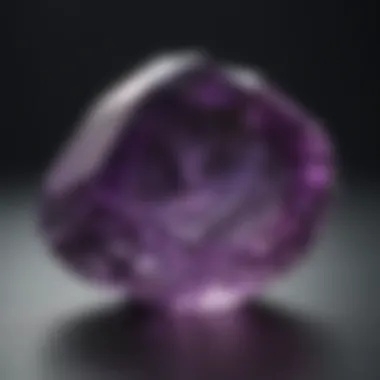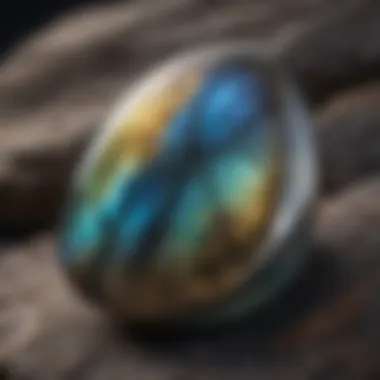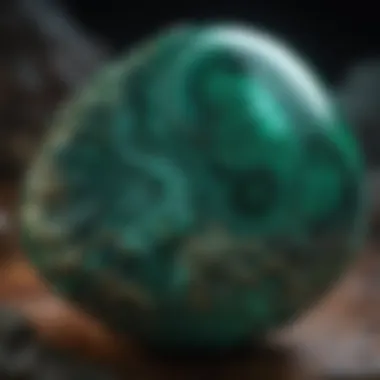Unveiling the Fascinating Realm of Polished Stones: A Definitive Exploration


Rock and Fossil Identification
In the realm of polished stones, rock and fossil identification plays a pivotal role in unraveling the mysteries held within these geological treasures. Enthusiasts and collectors immerse themselves in the diverse array of rock and fossil types, each possessing unique characteristics waiting to be discovered. From sparkling gemstones to ancient fossilized specimens, the journey of identification delves deep into the intricate world of geological wonders. Moreover, understanding the telltale signs that distinguish one type of rock or fossil from another requires a keen eye and a comprehensive knowledge of the underlying geological processes.
- Types of rocks and fossils:
Unraveling the world of polished stones unveils an array of rock and fossil types that span the spectrum of colors, textures, and compositions. From shimmering quartz crystals to fossilized remains preserved in sedimentary layers, each type presents a unique challenge and reward for collectors.
- Characteristics to look for:
Delving into the characteristics of rocks and fossils involves scrutinizing factors such as color, luster, hardness, and pattern. These distinguishing features serve as the building blocks for accurate identification, guiding enthusiasts towards unraveling the geological history encapsulated within each polished stone.
- Tools for identification:
Equipping oneself with the necessary tools for rock and fossil identification is essential for every collector. From mineral identification kits to specialized magnifying lenses, these tools serve as extensions of the collector's discerning eye, enabling precise analysis and classification of various specimens to enrich their collection.
Introduction to Polished Stones
In the vast realm of geological wonders, polished stones hold a distinguished allure that captivates enthusiasts and collectors alike. This section serves as the gateway into a captivating journey through the mesmerizing world of polished stones. By shedding light on the intricate details and significance of identifying these stones, readers are provided with a foundational understanding that sets the stage for further exploration and discovery. The importance of this introductory segment lies in its ability to provide key insights into the characteristics, value, and different types of polished stones.
Understanding the Appeal of Polished Stones
Aesthetics and Visual Appeal
Delving into the realm of aesthetics and visual appeal unlocks a world of mesmerizing beauty embedded in each polished stone. The play of color, clarity, and uniqueness in each stone draws in enthusiasts with an irresistible charm. Understanding the visual allure of polished stones enhances one's appreciation for their individuality and elegance, making them prized possessions for collectors. This section explores how aesthetics and visual appeal contribute to the overall charm and desirability of polished stones, making them a quintessential focus in the study and collection of these natural treasures.
Historical Significance
Exploring the historical significance of polished stones provides a window into the rich tapestry of human fascination with these geological marvels. From ancient civilizations to modern societies, the tradition of adorning oneself with polished stones for symbolic, cultural, and aesthetic purposes transcends time. Unraveling the historical context behind polished stones adds depth to their allure, showcasing their enduring appeal across diverse cultures and eras. This segment dives into the historical narratives that underscore the significance of polished stones, offering a glimpse into the stories and values attached to these timeless artifacts.
Spiritual and Healing Properties
Beyond their aesthetic charm, polished stones are imbued with spiritual and healing properties that resonate with many individuals seeking a deeper connection to the natural world. Beliefs in the metaphysical energies and healing capabilities of certain stones have been prevalent in various healing and spiritual practices worldwide. By examining the spiritual and healing properties of polished stones, readers can uncover the profound effects these stones are believed to impart on mind, body, and spirit. This section delves into the mystical and therapeutic aspects of polished stones, shedding light on their multifaceted nature.
Types of Polished Stones
Gemstones
Gemstones stand out as masterpieces of nature, exuding unparalleled beauty and allure. Their rarity, color brilliance, and durability make them coveted additions to any collection. Exploring the world of gemstones unveils a treasure trove of vibrant colors, exceptional clarity, and mesmerizing brilliance that captivate the beholder. This section delves into the allure and characteristics of gemstones, highlighting their unmatched value and desirability in the realm of polished stones.


Minerals
Minerals encompass a diverse spectrum of polished stones, each showcasing unique properties and characteristics that appeal to rock and fossil enthusiasts. From vibrant hues to distinct crystal structures, minerals offer a glimpse into the geological heritage of different regions. By examining the intricate details of minerals, collectors and scholars gain invaluable insights into the Earth's natural diversity and geological complexity. This segment delves into the fascinating world of minerals, elucidating their significance and appeal in the realm of polished stones.
Crystals
Crystals epitomize the harmonious fusion of beauty and metaphysical energy, enchanting observers with their intricate structures and energetic vibrations. Each crystal possesses its own energetic signature and healing properties believed to enhance various aspects of life. Exploring the enchanting realm of crystals unveils a world of spiritual growth, emotional healing, and energetic balance. This section delves into the mystical allure and holistic benefits of crystals, offering a deeper understanding of their profound impact on individuals' well-being.
Importance of Identifying Polished Stones
Authenticity and Value
The authenticity and value of polished stones play a pivotal role in determining their significance and appeal to collectors and enthusiasts. Distinguishing between authentic stones and imitations ensures the integrity of collections and investments. By understanding the characteristics that define authenticity and value in polished stones, individuals can make informed decisions when acquiring or evaluating these precious specimens. This segment highlights the importance of authenticity and value in identifying polished stones, emphasizing their role in preserving the integrity and quality of collections.
Personal Collection Curation
Personal collection curation embodies a journey of self-expression and admiration for the natural beauty of polished stones. Organizing and curating a collection reflects one's unique tastes, interests, and connections to the geological world. By delving into the art of personal collection curation, enthusiasts can create cohesive and meaningful collections that showcase their appreciation for polished stones' diversity and splendor. This section explores the intricacies of personal collection curation, guiding readers on a transformative exploration of their collecting passions.
Educational Purposes
The educational value of identifying polished stones extends beyond mere admiration, offering an enriching opportunity to delve into the geological and mineralogical realms. Studying polished stones enhances one's knowledge of mineral properties, geological formations, and lapidary techniques. By incorporating polished stones into educational pursuits, enthusiasts can deepen their understanding of Earth's natural history and the intricate processes that yield these captivating treasures. This segment underscores the educational significance of polished stones, advocating for their role in fostering learning, curiosity, and appreciation for Earth's geological wonders.
Characteristics of Polished Stones
In this section of the comprehensive guide on exploring the world of polished stones, we delve into the crucial topic of understanding the characteristics that define these stunning specimens. The characteristics of polished stones play a pivotal role in identifying, valuing, and appreciating these unique geological wonders. By examining elements such as color, texture, and pattern, enthusiasts and collectors can gain a deeper insight into the beauty and complexity of polished stones.
Color and Hue
Intensity
Intensity is a defining characteristic that greatly influences the visual impact of polished stones. The vividness and depth of color in a stone contribute to its allure and desirability. When evaluating intensity, factors such as saturation and tone are essential considerations. Intense colors can evoke strong emotions and make a stone stand out in a collection. However, overly intense colors may border on being unreal or artificially enhanced, impacting the stone's perceived value.
Clarity
Clarity refers to the transparency and clearness of a polished stone. Stones with high clarity are prized for their brilliance and light-reflecting properties. Clarity can significantly affect a stone's overall appearance and value, with flawless specimens commanding premium prices in the market. While clarity enhances the beauty of a stone, excessively clear stones may lack character and uniqueness, leading to a balance between purity and character.
Color Distribution
The distribution of color within a polished stone contributes to its visual interest and aesthetic appeal. Variegated patterns or symmetrical color arrangements can elevate the beauty of a stone, making it a captivating piece for collectors. Understanding how color is distributed in a stone can provide insights into its formation and composition. While balanced color distribution enhances the overall appeal of a stone, uneven or disproportionate color patterns may detract from its beauty and desirability.
Texture and Finish


Smoothness
The smoothness of a polished stone's surface influences its tactile appeal and tactile perception. A smooth texture invites touch and enhances the sensory experience of handling a stone. Achieving a perfect balance between smoothness and natural texture is crucial in the polishing process, as excessively smooth surfaces may lack character and authenticity.
Shine
Shine plays a crucial role in accentuating the beauty and brilliance of a polished stone. A high shine reflects light in a captivating manner, enhancing the stone's visual appeal and allure. Different polishing techniques can result in varying degrees of shine, with some finishes offering a subtle luster while others display a dazzling brilliance. Understanding the implications of shine on a stone's appearance is essential for collectors seeking exceptional specimens.
Polishing Techniques
The techniques used to polish stones significantly impact their final appearance and character. From achieving a high gloss finish to enhancing the stone's natural colors, polishing techniques play a crucial role in revealing the beauty hidden within each specimen. By exploring different polishing methods and their effects on texture and shine, collectors can appreciate the craftsmanship involved in transforming rough stones into polished treasures.
Pattern and Inclusions
Veining
Veining refers to the intricate patterns that traverse a polished stone, adding a layer of complexity and visual interest. Veins can range from subtle lines to elaborate swirls, each telling a story of the stone's geological journey. The presence of veining can enhance the uniqueness of a stone, providing collectors with insight into its formation and history.
Banding
Banding signifies the presence of distinct layers or bands of color within a polished stone. These bands can create striking visual contrasts and patterns, making the stone visually dynamic and captivating. The arrangement and intensity of bands contribute to the overall aesthetic appeal of the stone, with well-defined banding often sought after by collectors for its beauty and rarity.
Inclusions
Inclusions are internal characteristics or foreign materials that are encapsulated within a polished stone. These unique features can range from mineral crystals to organic matter, adding depth and intrigue to the stone. While some inclusions may detract from the stone's clarity, others can enhance its beauty and value by creating mesmerizing internal landscapes. Understanding the nature of inclusions in a polished stone is essential for appreciating its complexity and individuality.
Tools and Methods for Identification
In the realm of polished stones, the tools and methods for identification play a crucial role in uncovering the nuances and characteristics of these treasures. This section is a cornerstone of our comprehensive guide, shedding light on the significance of utilizing specific elements, benefits, and considerations when delving into the world of identifying polished stones.
Magnification Devices
Microscopes
Microscopes are indispensable tools in the identification of polished stones due to their ability to provide detailed views of the stone's structure and composition. Their key characteristic lies in the high magnification power, allowing for comprehensive examination of minute details such as inclusions, cleavage, and color distribution. This makes microscopes a popular choice in our article as they enable enthusiasts to explore the intricate features of polished stones effectively. However, a potential downside of microscopes is the need for proper calibration and skill to interpret the gathered information accurately.
Jeweler's Loupe
A jeweler's loupe serves as a portable and convenient magnification device ideal for examining polished stones on the go. The key characteristic of a jeweler's loupe is its compact size and high magnification capability, making it a beneficial choice for enthusiasts looking to inspect stones closely during field expeditions. The unique feature of a jeweler's loupe is its ease of use and affordability, allowing enthusiasts to enhance their understanding of stones without the need for bulky equipment. Yet, its disadvantage may lie in limitations regarding magnification power compared to other devices.


Magnifying Glasses
Magnifying glasses offer a versatile magnification solution for identifying polished stones, providing a balance between portability and magnification power. Their key characteristic includes adjustable magnification levels, making them a flexible choice for various stone examination needs in our article. The unique feature of magnifying glasses is their user-friendly design, allowing enthusiasts to easily switch between different magnification strengths based on the stone's characteristics. However, the potential downside of magnifying glasses may be a limitation in achieving high magnification levels for detailed analysis.
Common Mistakes in Identification
In the intricate world of polished stones, the topic of Common Mistakes in Identification holds significant importance. This section of the article sheds light on the critical errors that enthusiasts and collectors may unknowingly make, emphasizing the need for a discerning eye and meticulous attention to detail in distinguishing between genuine polished stones and imitations. Understanding and avoiding common pitfalls in identification not only enhances one's expertise in the field but also ensures the integrity of one's collection.
Misjudging Color Variations
Lighting Conditions
Unveiling the nuances of Lighting Conditions in evaluating polished stones is paramount in the realm of stone identification. The impact of lighting plays a crucial role in perceiving color variations, intensity, and clarity, influencing how a stone's features are observed and interpreted. Proper lighting conditions enable collectors to appreciate the true beauty and characteristics of polished stones, highlighting facets that may be overlooked in inadequate lighting setups. By mastering the art of utilizing diverse lighting sources, enthusiasts can refine their ability to discern minute details and accurately assess the quality of polished specimens.
Visual Perception
Delving into Visual Perception unveils the cognitive processes involved in analyzing polished stones. The human eye's interpretation of color, texture, and overall visual appearance is instrumental in identifying and appreciating the uniqueness of each stone. Understanding how visual cues shape our perception of polished stones equips collectors with insights into deciphering subtle differences and recognizing exceptional specimens. Visual Perception serves as a valuable tool in honing one's skills in identifying and distinguishing between various polished stones, adding depth to the collecting experience.
Enhancements
Exploring the realm of Enhancements in identifying polished stones opens avenues for understanding the potential alterations that may impact a stone's appearance and value. Enhancements encompass treatments and modifications that can deceive even seasoned collectors, highlighting the importance of critically evaluating stones for signs of artificial enhancements. By scrutinizing for enhanced features, enthusiasts can safeguard against acquiring misrepresented or artificially enhanced polished stones, preserving the authenticity and integrity of their collections.
Advanced Techniques for Experts
In the realm of polished stones, mastering advanced techniques is paramount for experts seeking to delve deeper into the exquisite world of gemstones and minerals. These techniques not only elevate the practitioner's understanding but also unveil hidden intricacies that escape the untrained eye. By meticulously employing methods such as spectroscopic analysis, X-ray diffraction, and electron microscopy, experts can unravel the mysteries shrouding polished stones, paving the way for groundbreaking discoveries and enhanced insights.
Spectroscopic Analysis
UV and Infrared Testing
UV and infrared testing stands as a cornerstone in the field of spectroscopic analysis, offering a profound glimpse into the molecular composition of polished stones. By subjecting specimens to ultraviolet and infrared radiation, experts can discern unique absorption patterns that unveil vital information about the gem's mineralogy and impurities. This method serves as a non-destructive approach for characterizing stones, allowing for precise identification and classification based on their distinctive spectral fingerprints. Despite its efficacy, UV and infrared testing necessitates specialized equipment and expertise, making it a preferred choice for experts seeking detailed insights without compromising the integrity of the specimen.
Chemical Composition Analysis
Delving into the chemical composition of polished stones is a fundamental aspect of spectroscopic analysis, shedding light on the elemental constituents that define each specimen's properties. By conducting meticulous chemical analyses, experts can discern trace elements, structural defects, and potential treatments present in the stone. This in-depth examination aids in unraveling the geological origins, metamorphic processes, and historical treatments undergone by the gemstones, enabling experts to make informed assessments regarding their authenticity and provenance. Despite its complexity, chemical composition analysis offers unparalleled insights into the inner workings of polished stones, empowering experts to unravel their mysteries with precision and accuracy.
Crystal Structure Examination
The examination of crystal structure forms a cornerstone in the arsenal of techniques available to experts in the field of polished stones. By scrutinizing the atomic arrangements within gemstones and minerals, experts can infer valuable information regarding their physical properties, optical behavior, and durability. This method enables experts to identify characteristic crystal shapes, twin boundaries, and defects that influence a stone's overall appearance and performance. Through crystal structure examination, experts can unlock the hidden stories encapsulated within polished stones, enriching their understanding and appreciation of these geological marvels while honing their discerning eye for quality and rarity.
X-ray Diffraction
The elucidation of gemstone properties through X-ray diffraction stands as a pinnacle in the field of mineralogical analysis, offering unparalleled insights into the atomic structures and mineral compositions of polished stones. By exposing specimens to X-ray beams and observing their diffraction patterns, experts can discern the crystallography, defects, and mineral phases present within the stone. This technique serves as a non-destructive method for investigating the internal structures of gemstones, facilitating accurate identifications and classifications based on their crystalline properties. Despite its technical complexity, X-ray diffraction remains a favored choice for experts seeking in-depth understandings of polished stones, enabling them to unlock the geological secrets hidden within each enigmatic specimen.
Electron Microscopy
The utilization of electron microscopy in the analysis of polished stones offers a microscopic glimpse into the intricate world of mineralogy and petrology, transcending the limitations of traditional optical methods. Through high-resolution imaging and elemental mapping, experts can explore the minute details of a stone's microstructure, surface textures, and elemental composition with unprecedented clarity. This method allows for the visualization of internal features, inclusion types, and growth patterns within gemstones, providing valuable insights into their formation histories and geological significance. Despite its specialized nature, electron microscopy empowers experts to peer into the hidden realms of polished stones, unlocking a wealth of information that enriches their understanding and appreciation of these geological treasures.







